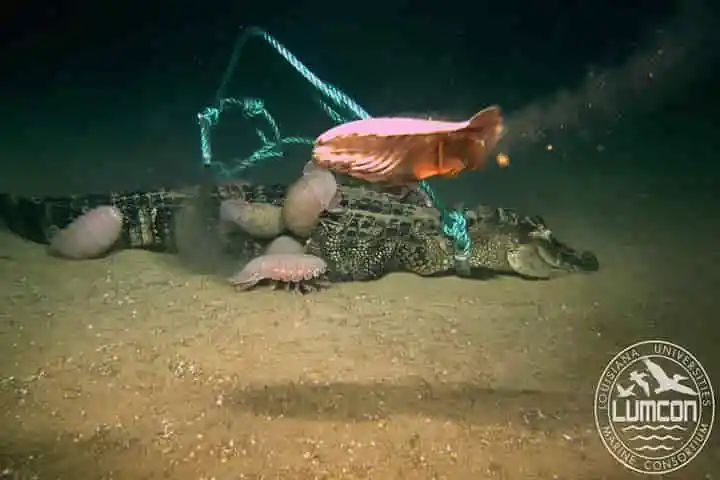

One of the alligators which was sent to the sea-floor as part of the Great Gator Experiment to study the food cycle underwater (Pic. Courtesy kify.com)
<p>
<strong>Ocean has also been an enigma for humankind and more so since it covers more than 70 per cent of the earth yet only five per cent of it has been explored!</strong></p>
<p>
Trying to unravel ocean&rsquo;s mysteries, scientists Craig McClain and Clifton Nunnally, from Louisiana Universities Marine Consortium, conducted a novel experiment a year ago. Known as the Great Gator Experiment, it was aimed to get new and deeper insights about the food cycle underwater.</p>
<p>
Three dead alligators were dropped by the two researchers for the unknown creatures of the seafloor. They were inquisitive to know as to how these dead reptiles would be consumed by them. Weights were tied to the bodies and sunk nearly two kilometres in the Gulf of Mexico after which they hit the seafloor.</p>
<p>
<iframe allow="accelerometer; autoplay; clipboard-write; encrypted-media; gyroscope; picture-in-picture" allowfullscreen="" frameborder="0" height="315" src="https://www.youtube.com/embed/54YezX7HeSI" title="YouTube video player" width="560"></iframe></p>
<p>
Incidentally, alligator is the State Reptile of Louisiana.</p>
<p>
<strong>Interesting findings</strong></p>
<p>
The fate of the first alligator was quickly settled as it was consumed within the first 24 hours. Giant isopods made a meal of it as soon as the researchers left the reptile. According to Nunnally, giant isopods are like deep-sea vultures.</p>
<p>
Others who joined isopods were amphipods, grenadiers and some mysterious, unidentifiable black fish, all scavengers. The reptile was opened up by the isopods who did it faster than expected.</p>
<p>
Now the second alligator flummoxed the scientists as they visited it after a period of 51 days and found parts of its bones with a reddish colour left on the bones. Talking to Atlas Obscura, McClain observed: &ldquo;That one genuinely surprised us. There was not even a single scale or scute left on the carcass.&rdquo;</p>
<p>
Following their examination, the team sent the remains to Greg Rouse, who is a marine biologist at the Scripps Institution of Oceanography. Lo and behold, it is there it was found that the animal had been broken down right up its bones by a new species.</p>
<p>
It was the Osedax genus, a bone-eating worm. Significantly, it is for the first time these worms have been discovered in the Gulf of Mexico and when their DNA was compared to other known species of Osedax, it was found to be a new species.</p>
<p>
<strong>The Vanishing gator</strong></p>
<p>
While the second gator was mysterious, the third left the team of scientists completely astounded. Visiting the site where they had dropped this last reptile, they found it was missing! The only clue was that there was a massive depression in the sand at the spot but the animal had vanished.</p>
<p>
Hectic search around the site yielded not even a trace except the weight attached around the creature, around 10 metres away.</p>
<p>
The surmise was that the predator animal was powerful enough to not only eat this huge reptile but also drag it around like a doll!</p>
<p>
The researchers and experts feel that it must be either a giant squid or a massive shark &ndash; which has yet to be discovered.</p>
<p>
With satisfactory results from this experiment, they two plan to do with a whale fall next time.</p>
Union Minister of Coal and Mines G Kishan Reddy on Tuesday held an inter-ministerial meeting…
India's largest automobile in-plant railway siding at Maruti Suzuki's Manesar facility started operation on Tuesday,…
Google on Tuesday unveiled its Safety Charter for India's AI-led transformation, at the "Safer with…
The human rights organisation of the Baloch National Movement (BNM), Paank, has published its most…
The Israel Defence Forces (IDF) on Tuesday claimed that it has killed Iran's senior-most military…
Amid escalating conflict between Iran and Israel, the Ministry of External Affairs (MEA) on Tuesday…